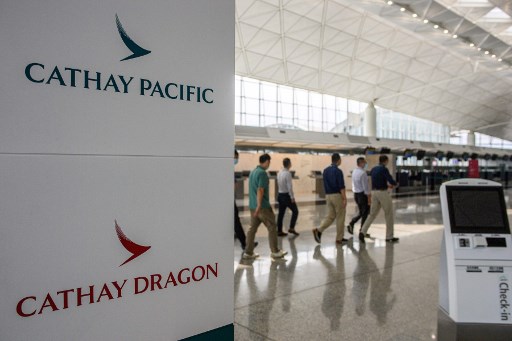
by Jerome TAYLOR / Su XINQI
Agence France Presse
Cathay Pacific announced plans Wednesday to cut its workforce by nearly a quarter and close one of its short-haul airlines in an effort to survive the “devastating” impacts of the coronavirus pandemic.
Across the globe, airlines have been hammered as the pandemic has slashed international travel, and they face a long, hard winter after a much-hoped-for rebound failed to materialise.
Cathay Pacific, Hong Kong’s flag carrier, published a corporate restructuring plan on Wednesday that will lead to 8,500 job losses in total — nearly a quarter of its workforce — and one of its airlines to disappear completely.
“The global pandemic continues to have a devastating impact on aviation and the hard truth is we must fundamentally restructure the Group to survive,” CEO Augustus Tang said in a statement.
Cathay said 5,300 redundancies would be made among the airline’s Hong Kong-based employees with a further 600 overseas.
The remaining losses would come from a recruitment freeze and natural attrition.
Cathay Dragon, a subsidiary that primarily flies shorter-haul flights within Asia, will cease operations.
The company is seeking regulatory approval to absorb some of Dragon’s routes into Cathay Pacific and its budget airline HK Express.
– Dismal year –
The news of cuts was embraced by investors with Cathay’s battered shares trading four percent up in afternoon trade.
But employees reacted with dismay, noting the proportion of jobs going was higher than many competitors.
Zuki Wong chairwoman of the Cathay Pacific Flight Attendants Union, said members were “severely disappointed”.
“We all feel very sad because the colleagues being laid off are all very dear to us,” she told reporters.
Hong Kong’s government came to the rescue of Cathay with a taxpayer-funded bailout of US$5 billion earlier this summer.
But Cathay CEO Tang said the airline was burning through up to HK$2 billion ($260 million) in cash each month during the pandemic.
“This is simply unsustainable. The changes announced today will reduce our cash burn by about HK$500 million per month,” he said.
Airline revenues plunged 80 percent in the first six months of the year, according to industry body IATA, but they still had fixed costs to cover — crew, maintenance, fuel, airport levies and now aircraft storage.
Repeated efforts to reassure passengers that air travel is safe have failed to make much of a difference while government restrictions, including quarantines of up to 14 days for returning passengers, have only added pressure.
Dozens of major airlines have slashed jobs in response.
– Half capacity next year –
Cathay, much like regional rival Singapore Airlines, has no domestic market to fall back on.
But even before the pandemic, Hong Kong’s marquee carrier was in a tight spot.
Months of huge and disruptive democracy protests in the city last year led to a plunge in customers, especially from the lucrative mainland Chinese market.
The airline also found itself punished by authorities in Beijing because some of its employees joined or voiced support for the protests.
By the time the pandemic hit at the start of the year, Hong Kong was already in recession and Cathay Pacific in the red.
There is scant hope on the horizon.
In a note to investors on Monday that detailed its most optimistic scenario, Cathay Pacific said it expected to run at half its pre-pandemic capacity next year.
One of the biggest disappointments for airlines has been the absence of highly lucrative business class travellers who prefer now to rely on tele-conferencing rather than run the risk of catching the virus.
Airlines are hopeful that better testing procedures at airports and “travel bubbles” between countries might encourage more people to fly.
Work on the latter has been slow, especially as the virus surges for a second time in Europe and North America.
Last week, Hong Kong and Singapore announced plans for a “travel bubble”.
Under the scheme, passengers who test negative for the virus will be able to travel on dedicated flights and not need to quarantine on arrival.
© Agence France-Presse







